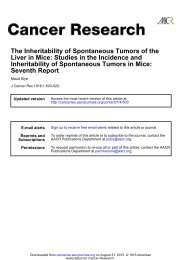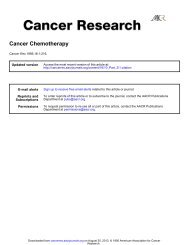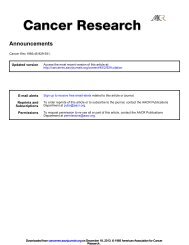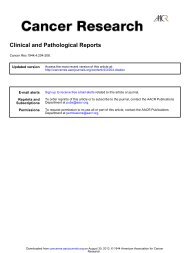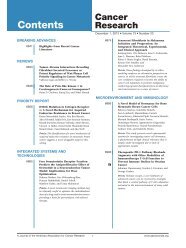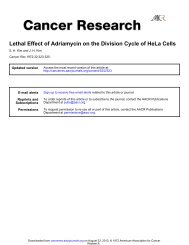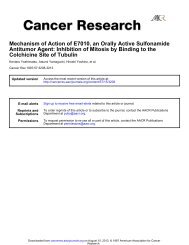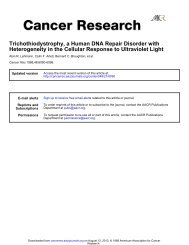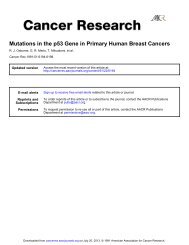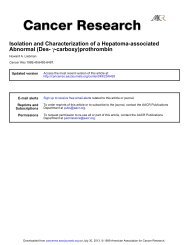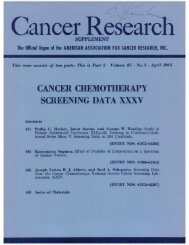Genetic Control of Resistance to Chemically ... - Cancer Research
Genetic Control of Resistance to Chemically ... - Cancer Research
Genetic Control of Resistance to Chemically ... - Cancer Research
You also want an ePaper? Increase the reach of your titles
YUMPU automatically turns print PDFs into web optimized ePapers that Google loves.
lOO-i SPRAGUE- DAWLEY<br />
2345<br />
00-5O-75250COPENHAGEN12345F<br />
O I 2<br />
Number <strong>of</strong> Mammary Adenocarcinomas/Rat<br />
Fig. 2. Distribution <strong>of</strong> the number <strong>of</strong> mammary adenocarcinomas per rat<br />
which developed in parental and hybrid crosses between NSD and COP female<br />
rats following a single p.o. feeding <strong>of</strong> 20 mg <strong>of</strong> DMBA. Based upon the animals<br />
presented in Table 1.<br />
Table 2 Incidence <strong>of</strong> mammary adenocarcinomas induced by i.v. MNU injection<br />
in parental and hybrid crosses between NSD and COP rats<br />
adenocarcinomas/ratType<br />
<strong>of</strong> female<br />
dosedNSD rat<br />
No. <strong>of</strong> mammary<br />
±0.40°(30/10)*<br />
COP<br />
0.00 (0/10)<br />
F, hybrids'<br />
0.40 ±0.13 (4/10)<br />
F2 hybrids'*Observed3.00<br />
1.00 ±0.35 (12/1 2)Expected<br />
' Mean ±SE.<br />
* Numbers in parentheses, ratio <strong>of</strong> the <strong>to</strong>tal number <strong>of</strong> mammary adenocarci<br />
nomas which developed <strong>to</strong> the <strong>to</strong>tal number <strong>of</strong> animals exposed <strong>to</strong> MNU per<br />
grouping.<br />
c NSD x COP F, hybrids.<br />
rfProduced by breeding NSD X COP F, hybrids.<br />
female rats produced by cross-breeding WF females (i.e., an<br />
other high susceptibility inbred strain), <strong>to</strong> male COP rats. At<br />
50 days <strong>of</strong> age, groups <strong>of</strong> 10 rats each <strong>of</strong> the WF, COP, and<br />
their FI hybrid strains were given 20 mg <strong>of</strong> DMBA p.o. Within<br />
1 year, the parental WF strain developed 2.7 ±0.26 mammary<br />
adenocarcinomas/rat while the parental COP strain developed<br />
no mammary cancers. The FI hybrids resulting from these two<br />
parental strains developed only 0.5 ±0.15 mammary adenocarcinoma/rat.<br />
These results are consistent with the inheritance <strong>of</strong><br />
a single dominant au<strong>to</strong>somal resistance alÃelefrom the COP<br />
genome being able <strong>to</strong> suppress DMBA induced mammary carcinogenesis<br />
in WF X COP heterozygous hybrids, although<br />
without the data on the I-• and backcross generations for this<br />
particular pair <strong>of</strong> rat strains this point is not in the strictest<br />
sense proven.<br />
DISCUSSION<br />
Previous studies have demonstrated that there is a definitive<br />
genetic component in the susceptibility <strong>to</strong> DMBA and MNU<br />
GENETIC RESISTANCE TO MAMMARY CANCER<br />
induced mammary adenocarcinogenesis. For example, Sydnor<br />
et al. (26) demonstrated that randomly outbred female SD rats<br />
are highly susceptible <strong>to</strong> a single feeding <strong>of</strong> DMBA (i.e., 3.8<br />
mammary cancers develop/rat), while randomly outbred and<br />
genetically different female Long-Evans (LE) rats are much less<br />
susceptible <strong>to</strong> a comparable feeding <strong>of</strong> DMBA (i.e., only 0.2<br />
mammary cancer/rat develop following a single exposure). This<br />
differential susceptibility, however, can be overcome if female<br />
LE rats are dosed multiple times with DMBA (i.e., 3.0 mam<br />
HYBRID1<br />
mary cancers/rat developed following 4 exposures). Chan et al.<br />
(27) likewise demonstrated that randomly outbred female SD<br />
I 2345<br />
rats are highly susceptible <strong>to</strong> MNU with 6 <strong>to</strong> 9 mammary<br />
cancers developing/rat depending on the type <strong>of</strong> fat diet (i.e.,<br />
F2 HYBRID<br />
high versus low) fed following a single injection <strong>of</strong> MNU. In<br />
contrast, this group demonstrated that the genetically different<br />
2345<br />
inbred female F344 rat is much less susceptible <strong>to</strong> a comparable<br />
F, »COP<br />
exposure <strong>to</strong> MNU with only 0.5 <strong>to</strong> 2.5 mammary cancers<br />
BACKCROSS<br />
developing/rat depending on the type <strong>of</strong> fat diet fed.<br />
The studies reported in the present paper have extended these<br />
12345<br />
previous genetic findings and have demonstrated that female<br />
F, i SO<br />
BACKCROSS<br />
NSD, WF, and LEW rats are as highly susceptible <strong>to</strong> DMBA<br />
exposure as the randomly outbread female SD rat. These con<br />
clusions agree with the studies <strong>of</strong> Shellabarger (28) and Moore<br />
et al. (29) which compared the DMBA susceptibility <strong>of</strong> SD <strong>to</strong><br />
LEW and WF female rats, respectively. The fact that the<br />
outbred SD, inbred NSD, inbred WF, and inbred LEW strains<br />
are all equally highly susceptible <strong>to</strong> DMBA could be due <strong>to</strong> the<br />
fact that all <strong>of</strong> these 4 strains are genetically related through a<br />
common derivation from the original breeding s<strong>to</strong>ck <strong>of</strong> the<br />
Wistar Institute, Philadelphia, PA (1). Female F344 and ACI<br />
rats, which are not derived from Wistar background, were found<br />
in the present study <strong>to</strong> be much less susceptible <strong>to</strong> DMBA<br />
induced mammary carcinogenesis than the previously cited 4<br />
based upon<br />
a single dominant<br />
au<strong>to</strong>somal<br />
resistance alÃele0.00<br />
Wistar related strains. Again, the data on the reduced suscep<br />
tibility <strong>of</strong> the F344 rat <strong>to</strong> DMBA agree with the reported<br />
findings <strong>of</strong> Moore et al. (29) and Gould (30). The reduced<br />
susceptibility <strong>of</strong> inbred Fischer was not restricted <strong>to</strong> DMBA,<br />
since essentially identical results were found using MNU as the<br />
0.95<br />
carcinogen as shown in the present study and as reported by<br />
Chan et al. (27).<br />
In contrast <strong>to</strong> all the other inbred strains <strong>of</strong> female rats tested,<br />
the COP rat was unique in its resistance <strong>to</strong> all attempts <strong>to</strong><br />
induce mammary adenocarcinomas by either DMBA or MNU<br />
exposure. The female COP rat is also unique in that, in direct<br />
contrast <strong>to</strong> the LE rat, attempts <strong>to</strong> overcome the resistance <strong>of</strong><br />
the female COP rat <strong>to</strong> DMBA induced mammary adenocarcin<br />
ogenesis by using multiple exposures <strong>to</strong> the carcinogen were<br />
completely unsuccessful. Treatment with the direct acting car<br />
cinogen, MNU, regardless <strong>of</strong> the route <strong>of</strong> administration or the<br />
number <strong>of</strong> exposures, was no more successful in inducing<br />
mammary cancers in COP rats than the indirect carcinogen,<br />
DMBA. This strongly suggests that a more complicated expla<br />
nation than merely carcinogen activation is responsible for the<br />
resistance <strong>of</strong> female COP rats <strong>to</strong> carcinogen treatment. The<br />
fact that female COP rats are also resistant <strong>to</strong> spontaneous<br />
(10), AAF (12), and estrogen (14), as well as DMBA and MNU<br />
induced mammary carcinogenesis suggests that the mechanism<br />
for the resistance <strong>of</strong> the mammary epithelium <strong>of</strong> the female<br />
COP rat must be a rather effective and general process for a<br />
large series <strong>of</strong> chemically unrelated carcinogens.<br />
Not all tissues in the female COP rat are resistant <strong>to</strong> DMBA<br />
induced malignant transformation (i.e., sarcomas and leukemias<br />
are inducible), the mammary epithelium <strong>of</strong> the female<br />
COP rat thus appears rather unique. In fact, COP mammary<br />
3961<br />
Downloaded from<br />
cancerres.aacrjournals.org on February 22, 2013<br />
Copyright © 1986 American Association for <strong>Cancer</strong> <strong>Research</strong>




